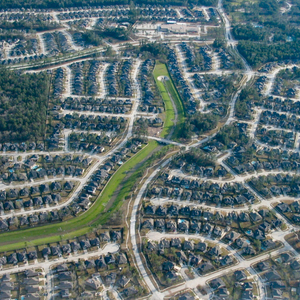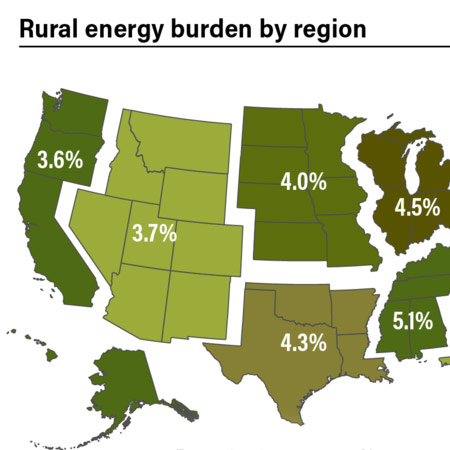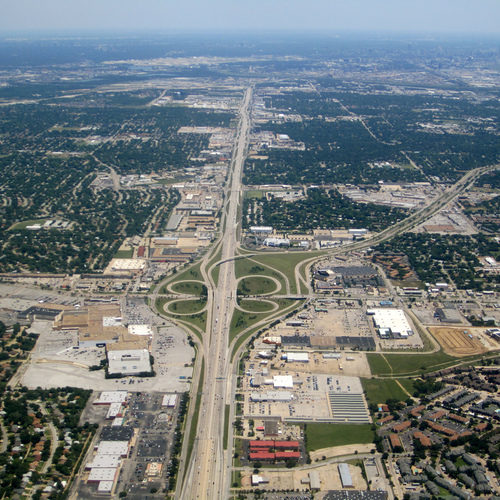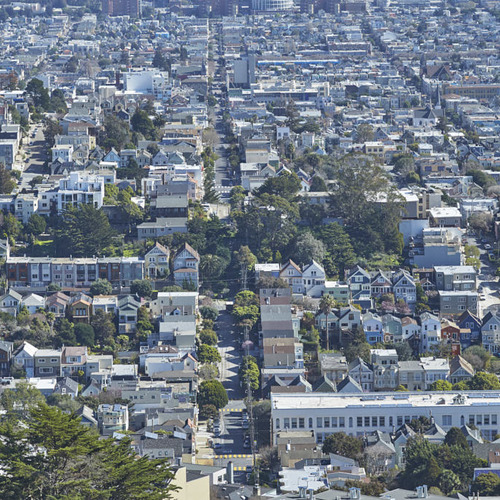
Image Credit: Wikimedia Commons
Suburban sprawl means less farmland and reduced agricultural productivity, dirtier air and water, and more traffic congestion, a new study says, and it all adds up to increased costs of about $1 trillion a year in the U.S.
The study by The New Climate Economy is an attempt to quantify the economic costs of sprawl (“dispersed, automobile-oriented, urban-fringe development”) while pointing out the benefits of compact, mixed-use building (“smart growth”).
“Sprawl provides various benefits, but these are mostly direct benefits to sprawled community residents, while many costs are external, imposed on non-residents,” the report says. “This analysis indicates that sprawl imposes more than $400 billion dollars in external costs and $625 billion in internal costs annually in the U.S., indicating that smart growth policies which encourage more efficient development can provide large economic, social and environmental benefits.”
In other words, sprawl can be great, if expensive, for people who live there, but not so great for people who don’t.
Higher transportation expenses, less mobility
Living in the suburbs inevitably means a lot more driving, and less walking, and that exacts a surprisingly high price.
Vehicle costs alone approach $3,000 a year, before adding costs associated with travel time, vehicle operation, parking, air pollution, water pollution, and traffic accidents.
Traffic death rates are two to five times as high in sprawled urban areas as they are in “smart growth communities.”
And because suburban development discourages walking, cycling, and public transportation, the authors said, it tends to impose “particularly large burdens on physically, economically and socially disadvantaged people.”
“To the degree that sprawl concentrates poverty in urban neighborhoods, it tends to exacerbate social problems such as crime and dysfunctional families,” it continues.
The authors said costs cited in the report reflect conditions in North America, but were transferable to developing countries.
“Although many of these costs are lower in absolute value in developing countries, due to lower wages and property values, they are probably similar relative to incomes and regional economies,” the report says. “As a result, smart growth policies that create more compact communities can provide substantial economic, social and environmental benefits in both developed and developing countries.”
Weekly Newsletter
Get building science and energy efficiency advice, plus special offers, in your inbox.















6 Comments
I know where this is heading...
Herding people into the city and stacking high-rise upon high-rise and making people living like rats with one person crawling over the other. Fence them in and mass transit, no more personal vehicles. No thanks, I'll pass!
I've heard (did you catch the homophone?) this environmental drumbeat before. They (this group of Eco-exteremists) want people to live in congested cities, have no cars, use mass transit, live in 500 sqft apartment high-rises and basically fence in the HUMANS so that they don't escape into the rural lands.
Fortunately we live in the USA and I can choose to live where I want to. If that means the burbs or some rural place and then drive, that is my freedom, my choice, my life. Thanks for the offer but I will pass on living in a megalopolis. New York City, Los Angeles, etc, NO THANKS.
Response to Peter L
Peter,
There is a middle road between the extremes you propose -- congested cities with high-rise apartments or suburban sprawl.
Many European cities have invested in the amenities and infrastructure to make urban life delightful. A few thoughtful features make all the difference: clean, affordable public transportation; bike lanes -- real bike lanes; limitations on vehicle traffic (including closing some streets to cars and trucks); good public facilities (schools, parks, and swimming pools) supported by broad taxes.
I know that most Americans will never have the chance to visit Amsterdam, Copenhagen, or Stockholm. But those who get that chance will probably be amazed at how civilized urban life can be -- if only citizens expect it, insist on it, and are willing to make investments that support livable, walkable, bikable cities.
Response to GBA Advisor
I visited Amsterdam and found it to be the most depressing city I have ever been to.
You no longer need to go to
You no longer need to go to Europe to experience this kind of city. Portland Oregon is probably the best example in the USA. Other good examples in North America that Ive visited are Toronto, Quebec, Vancouver, San Francisco and Seattle. Even small city’s like New Haven CT and Buffalo NY are becoming more and more livable and “Walkable”. If you’re interested to know more about this topic a great book is “Walkable City" by Jeff Speck.
Portland? Really?
I've been to Portland, OR a few times. (My step-daughter used to live there). I noted that the same snowbird bums who sleep on the streets of Tucson in the winter are sleeping on the streets of Portland in the summer.
The City of Tucson is island of liberal Democrats surrounded by a sea of conservatives. The city council positively swoons at the thought of Portland. Since Portland has a street car, the city "leaders" decided that Tucson should have one too. Even though the Portland-based company contracted to build their street cars was behind schedule, Tucson contracted with them anyway to build our street cars years behind schedule. But throwing enough federal money at it ($270M of your tax dollars, thank you very much) finally got it done.
For the heck of it, I rode it on opening day when it was filled with feeders at the public trough. It was SRO, The next day, and the day after that and the day after that too..., it was essentially empty.
All of this to "revitalize" downtown. But the only things vital downtown are government buildings, the courts, the lawyers that populate them and some trendy restaurants. On nights and weekends, the government goes home...to the suburbs.
San Francisco? Really?
SF is a blasted hellhole that is in the middle of pricing out its middle class, having already succeeded in driving out families and the poor through terrible land use policies. It is full of mentally ill homeless people that the city government refuses to do anything about. Taxes are high and the cost of living is off the charts. It is an absolutely horrible place to live unless you are rich and can afford to live in one of the trendy neighborhoods and commute via complementary tech bus to the south bay. Walkability is only one part of the puzzle. I live in a suburb that is highly walkable, with nearby grocery stores, restaurants, shopping, banks, churches, a park, and a public swimming pool.
Log in or create an account to post a comment.
Sign up Log in